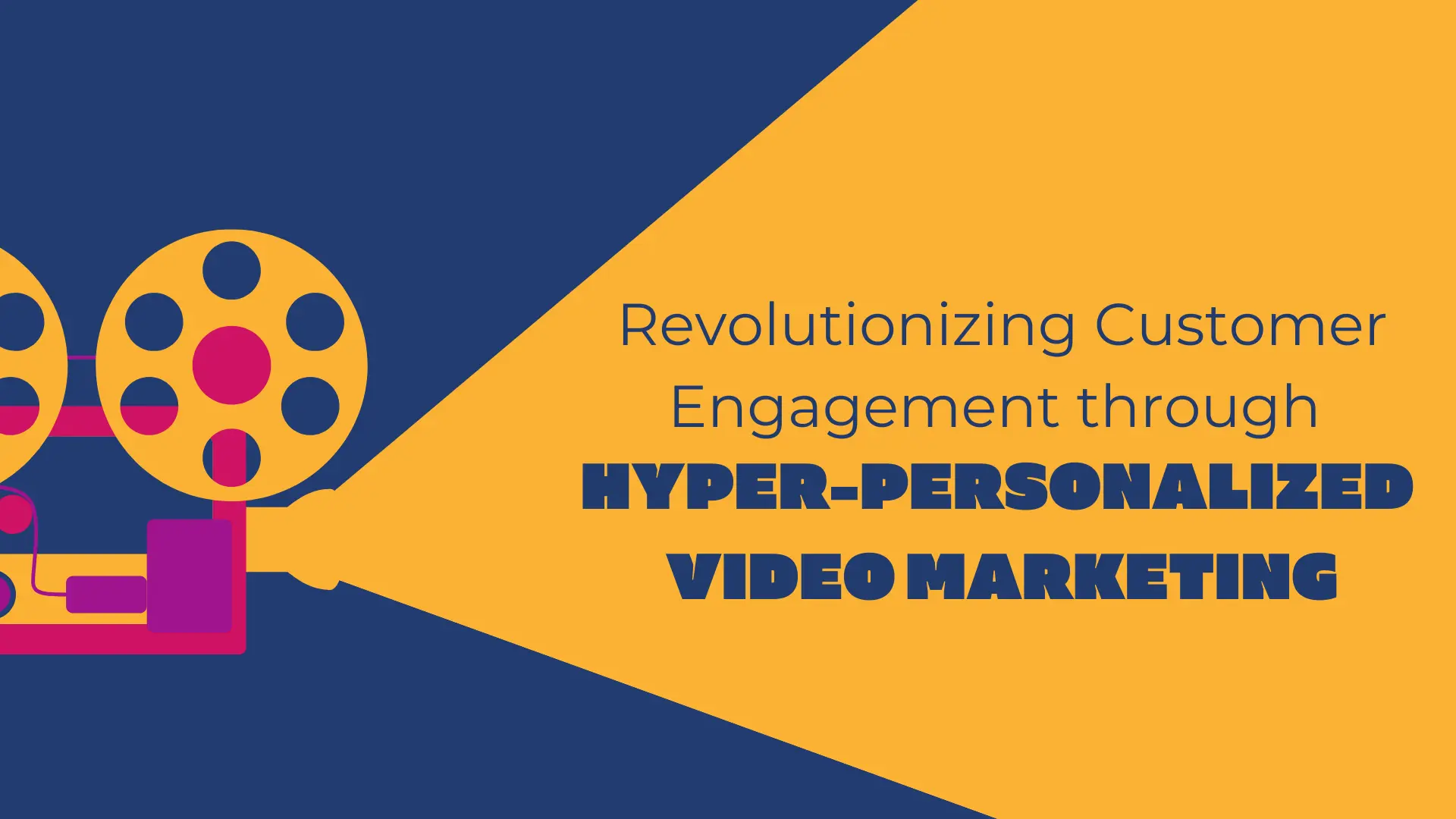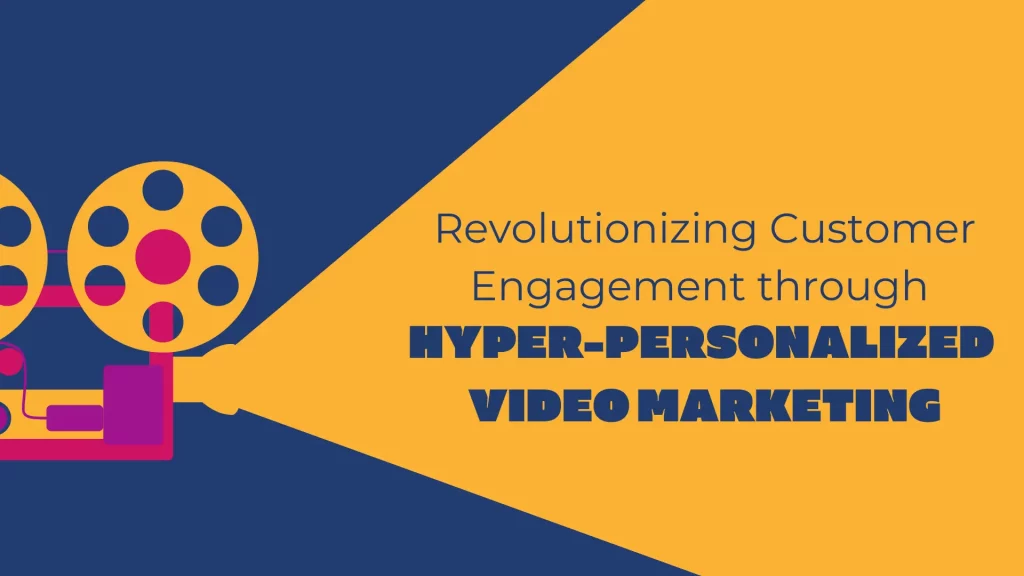Revolutionize your customer engagement strategy with the power of hyper-personalized video marketing. Here we are sharing our experiences to create targeted videos that will drive results.
“Get closer than ever to your customers; so close that you tell them what they need well before they realize it themselves.” – a famous quote from Steve Jobs.
Nowadays, customers prefer exceptional products or services and demand personalized interactions with the brands they follow. How you value customer experience can differentiate you from other companies and drive brand awareness and loyalty.
As businesses strive to meet customer expectations, the concept of personalization has evolved into hyper-personalization. While personalization customizes content and recommendations based on general preferences and behaviours, hyper-personalization takes it further. It leverages innovative technologies, such as Artificial Intelligence (AI) and Machine Learning (ML), to analyze vast amounts of customer data and deliver individualized experiences in real-time.
Hyper-Personalized Video Marketing
Hyper-personalized video marketing is an innovative strategy combining the power of video content, video editor features, AI, and data-driven personalization. It goes beyond generic video campaigns and dynamically adapts content to cater to each viewer’s preferences, interests, and behaviour. This approach enables brands to create immersive and relevant video experiences that deeply correlate with their intended consumers.
Hyper-personalized video marketing holds immense significance in the current business landscape. As consumers are exposed to a vast amount of content daily, captivating their attention and driving engagement has become increasingly challenging. Hyper-personalization enables brands to break through the noise and deliver content that genuinely matters to each individual, developing stronger emotional connections and increasing the chances of conversion.
The Role of Customer Data in Hyper-Personalization
At the core of hyper-personalized video marketing lies customer data. Businesses gather data from various touchpoints, such as website interactions, purchase history, social media behaviour, and customer feedback. This data is then analyzed to gain insights into individual preferences, interests, and buying behaviour.
Creating a 360-Degree Customer View
Businesses must create a 360-degree view of their customers to implement hyper-personalization effectively. It involves integrating data from different sources into a unified Customer Relationship Management (CRM) system. A comprehensive customer view enables brands to understand their viewers better and tailor video content accordingly.
Success Stories of Companies Implementing Hyper-Personalization
Sephora: A Case Study in Achieving Hyper-Personalization
The beauty retailer, Sephora, has embraced hyper-personalized video marketing to improve the online shopping experience for its customers. Sephora’s Virtual Artist feature uses augmented reality (AR) to allow users to try on different makeup products virtually.
They also provide personalized makeup tutorials and recommendations through interactive videos based on users’ facial features and preferences. This innovation has led to increased customer engagement and higher conversion rates.
Netflix: Leading the Way in Hyper-Personalized Content Recommendations
Netflix, the global streaming giant, is a pioneer in hyper-personalized content recommendations. Its recommendation algorithm analyzes individual viewing behaviour, preferences, and interactions with the platform to suggest highly relevant movies and TV shows. This approach has significantly contributed to Netflix’s customer retention and engagement.
The Impact of Hyper-Personalized Video Marketing
The importance of hyper-personalized video marketing cannot be overstated. Below are some of the impacts of hyper-personalized video marketing:
Building Emotional Connections with Customers
Hyper-personalized video marketing allows you to go beyond transactional interactions and create emotional connections with your customers. By providing personally relevant content, you can evoke emotions such as joy, nostalgia, or empathy, fostering a sense of loyalty and belonging among your followers.
Leveraging AI/ML and Modern Software Techniques for Scale
Implementing hyper-personalization at scale requires you to use advanced technologies such as AI and ML. These advancements can analyze vast amounts of data and make real-time content recommendations, ensuring that each of your viewers receives a personalized video experience, even in large-scale marketing campaigns.
Dynamic Co-creation: Personalization in Real-Time
Hyper-personalized video marketing enables dynamic co-creation with the consumers. You can integrate interactive elements, such as polls, quizzes, and personalized product recommendations, allowing your viewers to engage with the content and shape their viewing experience actively.
Addressing Privacy Concerns in Hyper-Personalization
While hyper-personalization offers you immense benefits, it also raises privacy concerns. You must prioritize data security and comply with privacy regulations to build trust with your customers. Obtaining explicit consent for data usage and providing transparent opt-out options are essential steps in addressing privacy concerns.
Implementing Hyper-Personalized Video Marketing
When you implement hyper-personalized video marketing, it’s best to keep the following steps in mind:
Step 1: Choose the Right CRM System for Data Integration
Selecting the appropriate CRM system is crucial for successful data integration. Your chosen platform should be capable of consolidating and analyzing customer data from various sources, ensuring a seamless hyper-personalization process.
Step 2: Identify Key Touchpoints for Video Marketing Personalization
Understanding the customer journey and identifying key touchpoints where video content can enhance engagement is also essential. These touchpoints may include onboarding, product discovery, customer support, and post-purchase follow-ups.
Step 3: Utilize Data Insights to Enhance Customer Engagement
You can use data insights derived from customer interactions to fine-tune hyper-personalized video marketing strategies continually. Analyzing customer feedback and behaviour can help you identify pain points and preferences, enabling you to optimize video content for better customer engagement.
For instance, if you notice customers visiting your audio joiner website but aren’t subscribing, try creating a personalized and customer-centric video explaining your product’s value and features.
Step 4: Customize Video Content to Specific Customer Segments
Segmenting the consumers based on demographic, behavioural, and psychographic factors allows you to customize video content to specific customer segments. This approach ensures your content is compatible with each group’s unique interests and needs.
Step 5: Interactive Video Experiences
Interactive video experiences, such as AI avatar creation or virtual try-ons, elevate customer engagement to a new level. You can create memorable and impactful interactions that drive conversions by involving the consumers directly in the content.
Hyper-Personalization and Video Storytelling
The most effective hyper-personalized video campaigns combine the right mix of storytelling and technology. This section discusses the correlation between hyper-personalization and video storytelling.
The Power of Storytelling in Video Marketing
Storytelling has been an age-old tool for captivating viewers and conveying powerful messages. In hyper-personalized video marketing, storytelling becomes even more potent, as it allows you to create narratives that align with individual viewers’ interests and aspirations.
Tailoring Video Narratives to Individual Customer Journeys
Each customer’s journey is unique, and hyper-personalized video marketing enables you to adapt your storytelling accordingly. You can guide viewers toward conversion and brand advocacy by crafting narratives aligning with specific customer journey stages.
Building Brand Loyalty through Personalized Video Campaigns
Hyper-personalized video campaigns that evoke emotions and relate to viewers’ values contribute to building brand reputation. When customers feel understood and appreciated, they are more likely to become passionate followers of your brand, increasing customer lifetime value.
Challenges and Solutions in Hyper-Personalized Video Marketing
Hyper-personalized video marketing is a complex undertaking, requiring specialized skills and technology that can be expensive to implement. The biggest challenge in hyper-personalized video marketing include:
Challenge 1: Scalability
One of the significant challenges in hyper-personalized video marketing is achieving scalability while maintaining individualized experiences. You can address this challenge by leveraging AI-powered automation tools that analyze data and deliver personalized content at scale.
Challenge 2: Data Security and Privacy
To build customer trust, you must prioritize data security and privacy. Implementing robust data protection measures and obtaining explicit consent from customers ensure that you conduct hyper-personalization responsibly and ethically.
Challenge 3: Technology Infrastructure and Investments
Implementing hyper-personalized video marketing requires adequate technology infrastructure and investments. You should allocate resources to adopt cutting-edge technologies and train personnel to utilize data-driven marketing tools effectively.
Challenge 4: Integrating Hyper-Personalization Across Channels
Hyper-personalization must extend across various channels, including websites, social media, emails, and mobile apps, to create a seamless customer experience. Integration ensures consistency and reinforces your brand’s commitment to individualized interactions.
Measuring the Success of Hyper-Personalized Video Marketing
So how do you measure the success of your hyper-personalized video marketing strategy? Here are a few key metrics to track:
Key Performance Indicators (KPIs) for Video Marketing
You can assess the effectiveness of hyper-personalized video marketing campaigns using various KPIs, such as click-through rates, video completion rates, conversion rates, and customer engagement metrics.
Analyzing Customer Engagement and Conversion Rates
Measuring customer engagement and conversion rates provides valuable insights into the impact of hyper-personalization on customer behaviour. You can use this data to optimize future video marketing campaigns.
Examining Case Studies
Examining case studies of successful campaigns in various industries can offer you valuable lessons and best practices to enhance your customer engagement strategies.
Future Trends
Advancements in AI and Machine Learning for Enhanced Personalization
As AI and ML technologies continue to evolve, hyper-personalized video marketing will become even more sophisticated. Real-time data analysis, predictive modelling, and advanced recommendation systems will redefine customer experiences.
Immersive Video Technologies
Immersive video technologies like VR and AR hold enormous potential for hyper-personalized video marketing. Brands can create interactive and lifelike experiences that immerse customers in personalized narratives.
Hyper-Personalized Video Advertising on Social Media Platforms
Social media platforms will play a vital role in the future of hyper-personalized video marketing. Brands will leverage user data from platforms like Facebook and Instagram to deliver personalized video ads to their customized viewers.
Final Thoughts
Hyper-personalized video marketing has the potential to revolutionize customer engagement, turning passive viewers into active participants. You can create meaningful connections and drive business growth by understanding each customer’s unique preferences and customizing content accordingly.
As businesses move toward a customer-centric future, it will become a cornerstone of successful marketing strategies. Brands prioritizing customer experience and leveraging data-driven insights will thrive in an increasingly competitive market.
Key Takeaways and Recommendations for Businesses
- Prioritize data security and privacy to build customer trust.
- Leverage AI and ML technologies for scalable hyper-personalization.
- Invest in immersive video technologies for engaging experiences.
- Measure KPIs to assess the impact of this strategy.
- Continuously evolve and adapt video marketing strategies based on customer insights.
In conclusion, hyper-personalized video marketing represents a transformative approach to customer engagement. You can deliver personalized video experiences that relate deeply with your consumers, developing lasting emotional connections and driving brand success by harnessing the power of data, advanced technologies, and compelling storytelling.
Read More Articles








